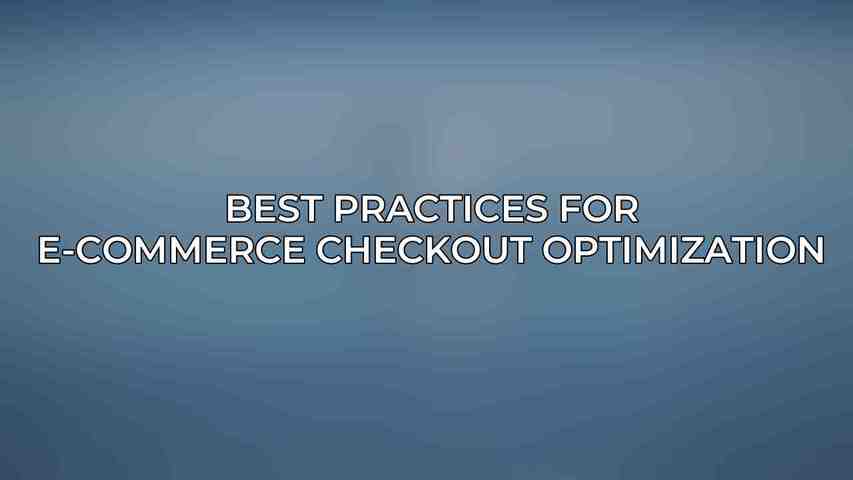checkout optimization is a crucial aspect that can significantly impact a business’s success. This process involves refining and enhancing the final step in the customer journey, where transactions are completed. E-commerce Checkout Optimization aims to make this stage as seamless and efficient as possible for customers, thus improving their overall shopping experience.
The importance of E-commerce Checkout Optimization cannot be overstated. By refining this critical phase, businesses can reap numerous benefits, including:1. Reduced cart abandonment rates,2. Increased conversion rates, and3. Improved customer satisfaction.
Pitfalls in E-commerce Checkout Processes
Several pitfalls can hinder the effectiveness of an e-commerce checkout process, leading to frustrated customers and lost sales. Some common pitfalls include:
– Complex and time-consuming checkout processes,
– Hidden or excessive costs,
– Lack of payment options, and
– Poor user experience.
Addressing these pitfalls is essential for businesses looking to optimize their checkout processes and drive higher conversions.
Best Practices for E-commerce Checkout Optimization

Efficient E-commerce Checkout Optimization involves implementing a range of best practices to streamline the process and enhance customer trust. Some key strategies include:
A. Simplification of the Checkout Process
- Streamlining steps and eliminating unnecessary fields.
- Automating address verification and input.
B. Transparency and Trust Building
- Clearly displaying all costs and fees.
- Utilizing security measures and trust seals.
- Providing clear and accessible privacy policies.
C. Variety of Payment Options
- Offering multiple payment gateways.
- Accepting mobile payments and digital wallets.
- Handling offline payments efficiently.
D. Mobile Optimization
- Ensuring a responsive checkout design.
- Utilizing one-page checkout and mobile payment methods.
- Providing a seamless checkout experience across all devices.
E. Personalized and Secure Checkout
- Customizing checkout based on user’s previous interactions.
- Implementing strong encryption measures.
- Providing a dedicated customer service channel.
F. Post-Checkout Improvements
- Sending order confirmations and tracking information promptly.
- Offering upsell and cross-sell opportunities.
- Providing clear return and exchange policies.
Tools and Technologies for E-commerce Checkout Optimization

There are various tools and technologies available to help businesses enhance their checkout processes, including:
– Checkout Conversion Software like Baymard Institute’s Checkout Optimization Guide and Shopify’s Checkout Accelerator,
– A/B Testing and Data Analysis tools such as Google Optimize and Hotjar, and
– Payment Processing Platforms like Stripe and PayPal.
These resources can provide valuable insights and solutions for optimizing e-commerce checkouts effectively.
Case Studies and Erfolgsbeispiele
Examining successful case studies can offer valuable insights into effective E-commerce Checkout Optimization strategies. Some noteworthy examples include:
– Amazon’s “1-Click Ordering”,
– Zappos’s “365-Day Return Policy”, and
– IKEA’s “Augmented Reality Furniture Placement”.
These case studies showcase how tailored checkout processes can drive remarkable results for e-commerce businesses.
the benefits of E-commerce Checkout Optimization are significant, ranging from improved conversions to enhanced customer satisfaction. Continuous improvement in this area is key to staying competitive in the ever-evolving e-commerce world. Looking ahead, future trends in E-commerce Checkout Optimization may focus on further personalization, innovative payment solutions, and enhanced security measures. By embracing these trends and best practices, businesses can elevate their checkout processes and delight customers at every transaction.
Frequently Asked Questions
1. What are some common reasons for cart abandonment during the checkout process?
Common reasons for cart abandonment include unexpected costs, complex checkout process, lack of payment options, and lengthy forms.
2. How can I simplify the checkout process to reduce cart abandonment?
You can simplify the checkout process by offering guest checkout, providing multiple payment options, minimizing form fields, and removing distractions.
3. Should I include progress indicators during the checkout process?
Yes, progress indicators help users understand where they are in the checkout process and how much more they need to complete, reducing anxiety and increasing completion rates.
4. What are some best practices for designing a mobile-friendly checkout process?
Best practices for mobile-friendly checkout include using a responsive design, optimizing loading times, and using mobile-first design principles to ensure a seamless experience on smaller screens.
5. How can I leverage data and analytics to optimize my e-commerce checkout process?
You can use data and analytics to track user behavior, identify pain points in the checkout process, and make data-driven decisions to improve conversion rates and reduce cart abandonment.

